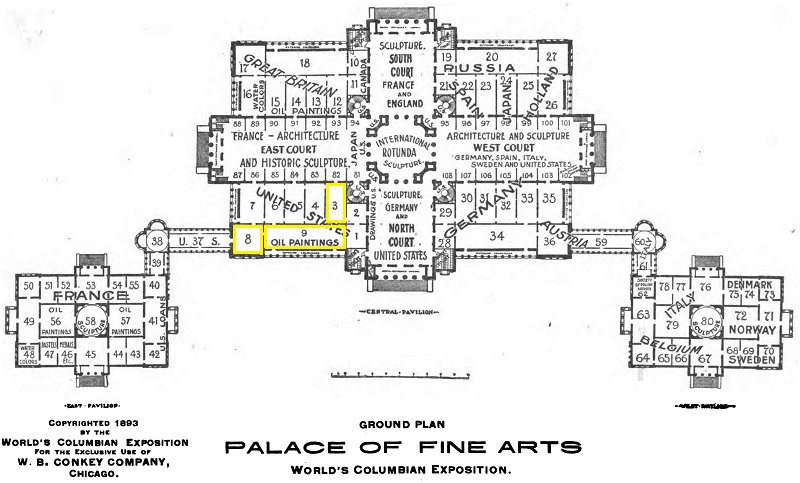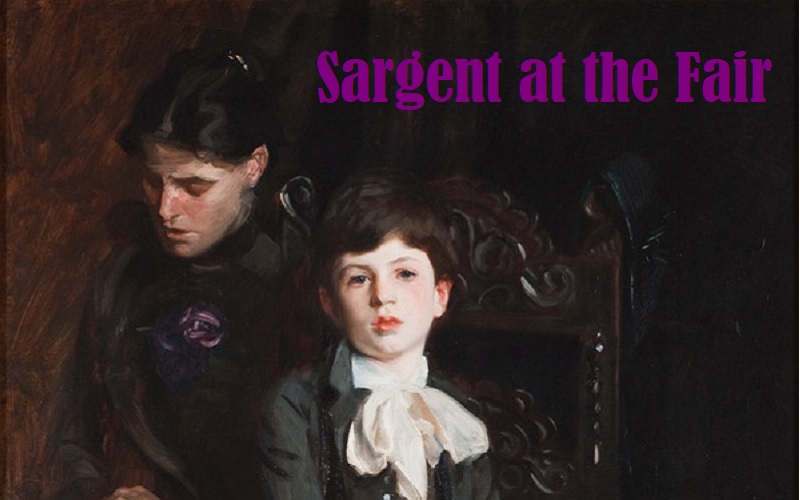John Singer Sargent (1856–1925) was one of the most talked-about American artists whose works were displayed at the 1893 World’s Columbian Exposition.
“Mr. Sargent easily leads the portrait painters,” wrote Ernest Knaufft in his review of art at the Exposition. “We should dislike to pick out any separate example, but taking him in the aggregate, he becomes the ideal painter for painters.” Another contemporary review of the Columbian Exposition art display observed that:
Nine out of ten of our younger artists of to-day, if asked to name the representative American portrait painter, would probably answer, John S. Sargent. And notwithstanding that Mr. Sargent lives so much abroad as to belong to France quite as much as to America, he has remained an American in sympathy. (Hitchcock, p. 159)
Nine of Sargent’s portrait paintings hung in the galleries of the Palace of Fine Arts; a summary of each follows. (The two numbers provided here correspond to those listed in World’s Columbian Exposition, 1893: Official Catalogue and Revised Catalogue, Department of Fine Arts, respectively.)
* During the summer of 2018, the Art Institute of Chicago is hosting the exhibition John Singer Sargent and Chicago’s Gilded Age, which reunites four of these nine paintings.

Floor plans of the Palace of Fine Arts, showing the galleries in which John Singer Sargent displayed his painting (shown in yellow). [Images from The Revised Catalogue, Department of Fine Arts (Conkey, 1893).]
Mother and Child (Portrait of Mrs. Edward L. Davis and Her Son, Livingston Davis) from the Los Angeles County Museum of Art.
Mother and Child (Portrait of Mrs. Edward L. Davis and Her Son, Livingston Davis), 1890.*
(#875, #809) This 86 1/8-by-48 1/4-inch oil painting hung on the south wall of Gallery 8.
The subject is Maria Louisa “Lulu” Robbins Davis (1843-1916), a prominent woman of Worcester, Massachusetts, and her son Livingston (1882-1932).
Lent to the Exposition by Mr. Edward Davis of Boston, the painting resides in the collection of the Los Angeles County Museum of Art.
Portrait of Ellen Terry as Lady Macbeth from the Tate Gallery.
Portrait of Ellen Terry as Lady Macbeth, c. 1889.
(#876, #577) This 87-by-45-inch oil painting hung on the west wall of Gallery 3.
The subject is actress Dame Ellen Terry (1847-1928) wearing her costume for her role as Lady Macbeth. About this “remarkable” and a “fine picture,” the Chicago Tribune offered this description (“Fine Arts at the Fair”):
Mr. Sargent has painted her at that awful moment after the apparition of Banquo, when the affrighted guests have been dispersed and the unnerved Macbeth has broken down from sheer terror. The Queen, who has preserved her self-control throughout the ordeal, stands to her full height, and lifts the heavy crown from her brows. She had just uttered “a kind good-night to all”; and now for a moment all the suppressed emotions are reflected in the strained features. The lips are parted like those of a hunted animal; the eyes are suffused with tears and terror-stricken, and the effect upon the spectator is one of unutterable pathos. Barbaric splendor is suggested in the coloring—in the greenish regal garment, in the scared white face, in the impending aureole of gold, in the two long braids of tawny hair. Not without the sign of effort, not without a suspicion of theatricality, but a great picture nevertheless.
Painter and art writer William Walton wrote extensively about Sargent’s contributions to the American exhibit and dwelled on this particular painting (p. 16):
Among the most interesting and important of these picked canvases is Mr. Sargent’s portrait of Miss Ellen Terry as Lady Macbeth, owned by Henry Irving and first exhibited at the New Gallery in Regent street in the Spring of 1889. It was not there hung, as at Chicago, as a “centre,” but it blazed out even more vehemently among the pale and respectable English pictures. The British matron paused a moment before it, said “Oh! I don’t like that!” and passed on. The painter undertook to epitomize the tragedy of “Macbeth” in the portrait of an actress; he gave her an attitude—holding the crown of Scotland poised over her head with both hands—which she nowhere assumes in the play, and he took the sober and harmonious tones of her costume and her braided hair and pushed them up in the scale to a pitch of barbaric splendor and color. The face is very pale and with all the actress’ tricks of “make-up” and expression accentuated by the courageous painter, the attitude is fierce and proud, the likeness is evident,—it is a portrait and a drama, both at once.
Journalist Julian Hawthorne offered this interesting impression:
… there is a really tremendous portrait of Ellen Terry, as Lady Macbeth, holding the blood-stained crown over her head. The whole composition, with the exception of the ghastly white face and arms, is a study of peacock blues and greens. It is so in tensely rich and strong that everything else in the room looks feeble and colorless. You cannot look long at it without exhaustion.”
One has to wonder if Hawthorne realized that four other paintings by Sargent also hung in the same gallery and was counting them among the “feeble and colorless.”
Lent to the Exposition by Mr. Henry Irving of London, Portrait of Ellen Terry as Lady Macbeth now resides in the collection of the Tate Gallery, London.
Portrait (Alice Mason); image from The Athenaeum.
Portrait (Alice Mason), 1885.
(#877, #680) Hung on the north wall of Gallery 9.
The subject is Mrs. Alice Mason (1838-1913), wife of Charles Sumner, U.S. Senator from Massachusetts and abolitionist famous for having been physically assaulted on the Senate floor.
The painting now resides in a private collection.
Study of an Egyptian Girl from the Art Institute of Chicago.
Study of an Egyptian Girl, c.1891.*
(#878, #1043) This 73-by-23-inch oil painting was displayed away from Sargent’s other works, in Alcove 118 on the second floor of the Art Palace.
Sargent traveled to Egypt in 1891 and painted this nude figure study in a Cairo studio. Reportedly this was the only female nude oil painting of his career. Walton describes the study as:
… the full-length, life-size, figure of a slender Egyptian girl, standing with her back to the visitor but obligingly twisting herself round on her supple waist to braid the long locks of her black hair and show him her pretty Oriental profile. Near this picture, which the chaste commissioners have banished to a screen in the upper galleries, hangs another life-sized painting of unashamed nudity by Mr. Bridgmann [sic], startlingly white in itself and rendered still whiter by the contrast with the smooth olive tints of the Egyptienne.
In this passage, Walton is referring to Frederic A. Bridgman’s Day Dreams.
Study of an Egyptian Girl now resides in the collection of the Art Institute of Chicago.
Portrait of Mrs. Inches from the Museum of Fine Arts, Boston.
Portrait of Mrs. Inches, 1887.
(#879, #522) This 34-by-23 7/8-inch oil painting hung on the north wall of Gallery 3.
The subject is Mrs. Charles E. Inches (nee Louise Pomeroy) who lived near Sargent, at 88 Charles Street in Boston. Walton describes it as “very proud and spirited, her purple velvet dress skillfully and summarily painted.”
Lent to the Exposition by Dr. C. E. Inches, this painting resides in the collection of the Museum of Fine Arts, Boston.
Portrait (Katherine Chase Pratt); image from the Athenaeum.
Portrait (Katherine Chase Pratt), c. 1890.
(#880, #509) This 40-by-30-inch oil painting hung on the north wall of Gallery 3.
The subject is fourteen-year-old Katherine Chase Pratt (1875-1942). Sargent painted another portrait of Miss Pratt in 1890.
Lent to the Exposition by her father, Mr. Frederick Sumner Pratt, of Worcester, Mass, this painting currently is held in a private collection.
Portrait of a Boy (Homer Saint-Gaudens and His Mother) from the Metropolitan Museum of Art.
Portrait of a Boy (Homer Saint-Gaudens and His Mother), c. 1890.*
(#881, #686) This 59 ¾-by-56-inch oil painting hung on the north wall of Gallery 9.
The subject is the ten-year-old Homer Saint-Gaudens (1880–1958), son of the American sculptor Augustus Saint-Gaudens (who contributed his Diana to the roof of the Agricultural Building and lent this portrait painting to the Exposition). Standing behind the boy in the portrait is his mother, Augusta (1848–1926). William Walton (p. 16) notes that “the mother reads quietly, a little in the shadow, while her small son standing by her knee, looks at you.”
Hitchcock (p. 159) describes the painting as:
“a good specimen of Mr. Sargent’s more important work. The extreme pains bestowed upon the head of the boy is noticeable in contrast with the sketchy but highly effective treatment of details and background. Foreign critics agree in finding more of the spirit of the great masters of portrait painting in Sargent’s work than in any other of our American painters.”
The painting now resides in the collection of the Carnegie Museum of Art in Pittsburgh.
Portrait (Miss Helena Dunham); image from Curiator.
Portrait (Miss Helena Dunham), 1892.
(#882, #513) This 48-by-32-inch oil painting hung on the north wall of Gallery 3.
Among his painting at the 1893 World’s Fair, this was Sargent’s most recent work. Walton described it as a “three-quarter length of a handsome lady in white with her hands suddenly clasped in her lap.”
Lent to the Exposition by Mr. Dunham of New York, this painting currently resides in a private collection.
Portrait (Alice Vanderbilt Shepard) from the Amon Carter Museum.
Portrait (Alice Vanderbilt Shepard), 1888.*
(#883, #515) This 30 1/8-by-22-inch oil painting hung on the north wall of Gallery 3.
The subject is thirteen-year-old Alice Vanderbilt Shepard (later Morris), great granddaughter of railroad magnate Commodore Cornelius Vanderbilt. Oscar Wilde supposedly once quipped there were but three destinations worthy of a traveler’s attention in the United States: Niagara Falls, the Grand Canyon, and Alice Shepard.
Lent to the Exposition by newspaper publisher Mr. Elliott F. Shephard of New York, this painting resides the collection of the Amon Carter Museum, Fort Worth, Texas.
ACKNOWLEDGEMENTS
Special thanks to K.S. for information about the Art Institute exhibit.
SOURCES
“Fine Arts at the Fair” Chicago Daily Tribune July 2, 1893, p. 25.
Hawthorne, Julian “The Lady of the Lake. At the Fair.” Lippincott’s Magazine August 1893, pp.24047.
Hitchcock, Ripley (ed.) Art of the World Illustrated in the Paintings, Statuary, and Architecture of the World’s Columbian Exposition. Vol. II. D. Appleton and Co., 1893.
Knaufft, Ernest “Art at the Columbian Exposition” Review of Reviews June 1893, pp. 551-63.
Revised Catalogue, Department of Fine Arts. Conkey, 1893.
Revisiting the White City. Smithsonian Institution, 1993.
Walton, William Art & Architecture, Volume 1: The Art. G. Barrie, 1893.
World’s Columbian Exposition, 1893: Official Catalogue Part VII. W. B. Conkey Company, 1893.

